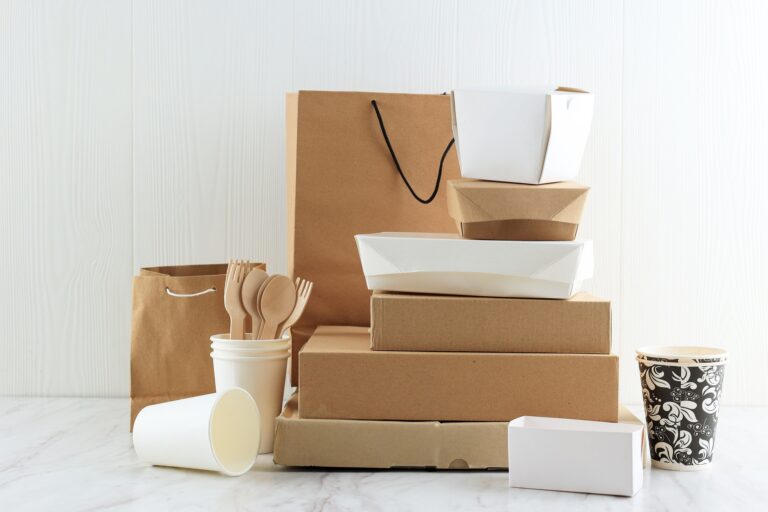French Fries Packaging for Foodservice
We provide a complete range of French fries packaging designed for fast food, takeout, and delivery operations. Options include kraft paper cones, scoop cups, boxes, and trays—each crafted for heat retention, oil resistance, and ease of use. Available in multiple sizes and styles, our packaging ensures clean handling, attractive presentation, and eco-friendly performance. Custom printing and food-grade coatings are also available to meet your branding and product needs.
Types of French Fries Packaging
We offer a full range of French fries packaging, including cones, scoops, trays, and boxes. Designed for heat insulation, grease resistance, and ease of use in fast food and delivery.
French Fries Carton Boxes
Carton-style French fries packaging is sturdy and versatile, suitable for both dine-in and takeaway. Often designed with ventilation holes to keep fries crispy, they are available in different sizes to match portion requirements.
French Fry Scoop Cups
Scoop cups are ideal for single-portion fries. Designed with an open-top structure for quick serving and easy consumption, they are made from grease-resistant kraft paper or food-grade coated board. Widely used in quick-service restaurants and snack stands.
Cone Boxes
Cone boxes feature a tapered, ergonomic design that fits comfortably in one hand, making them perfect for street food, food trucks, and events. They allow excess oil to drain naturally and can be paired with dipping sauce holders for added functionality.
Professional Supplier of French Fries Packaging for Global Foodservice
All of our French fries packaging products are manufactured under strict quality control standards using certified food-grade materials. We offer flexible production capabilities to support both small orders and large-scale supply needs. Our packaging solutions comply with global environmental standards, including certifications for compostability, recyclability, and FSC sourcing, helping foodservice brands reduce plastic usage and improve sustainability efforts.
We offer fast delivery times, responsive support, and fully customizable packaging with options for branding, colors, and structural design. We have long-standing partnerships with large fast-food chains, regional distributors, and independent restaurants. Whether you are launching a new brand or expanding your global food business, we can support your growth with high-performance, protective, and promotional packaging solutions.
Materials Used in French Fries Packaging
The quality and performance of French fries packaging depend on the material used. Each option provides different levels of durability, grease resistance, and sustainability, making them suitable for various food service applications.
Kraft Paper
A strong, natural-looking paper material widely used for fry scoops, sleeves, and cones. It is lightweight, recyclable, and can be coated to enhance oil resistance. Ideal for brands looking for a rustic and eco-conscious appearance.
PE-Coated Paperboard
Paperboard lined with polyethylene (PE) offers improved durability and grease resistance. Commonly used for rigid fry boxes and compartment containers where structure and leak protection are important.
PLA-Coated Paper
PLA (Polylactic Acid) is a plant-based, compostable coating applied to paper to improve moisture and oil resistance. This material is suitable for brands that prioritize plastic-free and compostable food packaging solutions.
Bagasse (Sugarcane Pulp)
A compostable fiber material made from sugarcane waste. It is thick, strong, and heat-resistant, making it suitable for tray-style packaging or combo containers that include fries.
Recycled Paperboard
Made from post-consumer recycled paper, this material supports sustainability while offering moderate oil resistance. Best for dry or low-fat fry products served in casual or high-volume settings.
White Cardboard
Smooth-surfaced material that allows high-quality printing for branding. Coated versions provide resistance to oil and moisture, making them suitable for fry boxes and window cartons.
Choosing the Ideal French Fry Packaging Container
When selecting packaging for French fries, you must weigh multiple functional, operational, and customer-facing factors. The following considerations are essential to making a decision that protects your product, supports your brand, and improves the end-user experience.
Specific Business Needs
Packaging should reflect how your business operates. A food truck requires different packaging than a national fast-food chain or a dine-in restaurant. The speed of service, serving style (takeout vs. dine-in), and customer interaction all influence what kind of container works best. A mismatch between packaging design and business flow can cause delays, reduce efficiency, or lead to product damage.
Package Size and Serving Size
Portion consistency is critical for cost control and customer satisfaction. If the packaging is too small, fries may spill out; too large, and the portion may look insufficient. Properly matched serving sizes ensure uniformity, help manage food cost margins, and maintain a professional appearance with every order.
Ventilation
French fries release steam when hot. If this moisture is trapped inside a sealed container, it quickly turns crispy fries into soggy, unappetizing ones. Proper ventilation in packaging allows steam to escape, preserving the desired texture of the fries until they are consumed—especially critical for deliveries and takeout orders.
Grease Resistance
Fried foods naturally contain oil, and if the packaging material absorbs or leaks grease, it results in a messy, unprofessional appearance. Customers often judge food quality by presentation, and visible grease stains can lead to negative impressions. Using grease-resistant materials ensures cleanliness and protects the overall dining experience.
Balancing Cost-Effectiveness and Quality
Cheaper materials may reduce upfront costs but often fail to meet customer expectations in terms of durability or insulation. Poor-quality packaging can negatively impact product quality, brand perception, and customer loyalty. Investing slightly more in better packaging often pays off through repeat business, fewer complaints, and stronger branding.
Considering Materials
The material of the packaging influences environmental impact, food safety, and brand values. For example, eco-conscious customers increasingly favor biodegradable or compostable containers. On the other hand, poor material choices can affect fry temperature, texture, and compliance with local food regulations. Choosing the right material ensures both performance and brand alignment.
Common French Fry Packaging Sizes and Serving Sizes
| Serving Size | Approximate Fry Weight (g) | Recommended Packaging Type | Packaging Dimensions (L x W x H in cm) |
|---|---|---|---|
| Kids/Small | 70–100g | Small paper cone or fry cup | 7 x 5 x 10 |
| Regular | 100–150g | Fry sleeve or paper box | 8 x 6 x 12 |
| Medium | 150–200g | Clamshell or fry boat | 10 x 7 x 13 |
| Large | 200–300g | Tray with vented lid | Industrial only |
| Family/Sharing | 300–500g | Large clamshell or multi-compartment box | 18 x 12 x 15 |
Customized French Fry Packaging
Standard packaging may work, but customized packaging is where true brand differentiation happens. It’s not just about logos.
- Custom die-cut shapes (cone holders, divider trays, foldable trays)
- Heat-retentive inner linings for prolonged crispiness
- Greaseproof & leakproof layers with eco-friendly coatings
- Brand-specific color schemes and full-color logo printing
- Sustainable material options including kraft paper, bagasse, and bamboo fiber
- Low minimum order quantities (MOQ) for small businesses
- Quick turnaround on seasonal or promotional packaging runs
How the Shape of a French Fry Rack Affects Its Capacity?
The geometric shape of the french fries container—whether conical, box-shaped, cup-shaped, tray-shaped, or sleeve-shaped—not only directly affects the amount of fries it can hold, but also influences the quality and appeal of the fries during storage and consumption. This subtle yet crucial design element impacts everything from food costs to customer satisfaction. Here are a few design implications:
Tall & Narrow Shapes
Pros: Heat retention, compact design
Cons: Hard to access the bottom fries, poor visibility
Wide & Shallow Shapes
Pros: Good presentation, easy dipping
Cons: Faster cooling, more surface exposure
Divided Compartments
Pros: Ideal for combos or sauces
Cons: Costlier to produce
Dine-in and Takeout Packaging Features
The difference between dine-in and takeout service goes far beyond the mode of consumption—it directly influences packaging decisions. What works in a controlled restaurant environment may fail in a dynamic delivery scenario.

Packaging for Dine-In Service
In dine-in settings, food is consumed shortly after preparation, meaning packaging can focus more on presentation, convenience, and waste reduction rather than insulation or durability.
- Open-top trays or boats that showcase fries attractively
- Minimal ventilation needs, as fries are consumed immediately
- Reusable or recyclable materials, especially in casual dining or upscale fast-casual
- Emphasis on branding, allowing for bold logos and storytelling on the tray

Packaging for Takeout and Delivery
For takeout and delivery, the stakes are much higher. French fries must endure transit time without losing heat, texture, or shape. Here, the packaging must act as both a container and a preservation system.
- Effective heat retention through double walls, insulation, or foil lining
- Strategic venting to prevent sogginess while maintaining temperature
- Sealed lids or flaps to avoid contamination and spillage
- Structural strength to withstand handling by delivery personnel
- Tamper-evident sealing for food safety assurance
French Fry Packaging Surface Treatment
One key reason for surface treatment is grease resistance. French fries release oil, and untreated paper or cardboard will quickly become saturated, leading to breakage or mess. Surface treatments create a barrier that prevents oil from penetrating the material. From a branding perspective, surface treatments also allow for high-quality printing, which is vital for custom-branded packaging. Smooth, treated surfaces result in sharper, more vibrant colors and greater durability under handling. Common surface treatments include:
PE Coating (Polyethylene)
Provides effective oil and moisture resistance.
Clay Coating
Offers a natural barrier and is often used in recyclable packaging.
Water-based Coatings
Eco-friendly alternatives that offer moderate resistance without hindering recyclability.
Anti-slip Coatings
Improve handling and stacking during transport and service.
Safety and Food Compliance
Safety in food packaging is non-negotiable. The materials, coatings, and inks used must not migrate harmful substances into the food or compromise the consumer’s health. French fries, being high in fat and often consumed directly from the container, are particularly sensitive to contamination risks.
Global Food Safety Regulations
Food packaging must meet local and international safety guidelines. Some of the most widely recognized standards include:
- FDA (U.S. Food and Drug Administration): Sets guidelines for direct food contact materials
- EU Framework Regulation (EC) No. 1935/2004: Ensures materials do not release unsafe levels of substances into food
- China’s GB standards: Covers all aspects of food packaging safety, from inks to adhesives
- FSSAI (India): Requires migration testing and declaration of all packaging components
Essential Compliance Measures
Reliable packaging partners should be able to supply certificates of compliance and support clients through audits and inspections. To ensure safety and compliance, manufacturers should:
- Use certified food-grade materials only
- Provide migration test reports for laminates and coatings
- Avoid toxic inks or solvents during branding
- Maintain traceability across the supply chain
FAQs
Use vented, insulated containers with moisture-wicking materials and avoid sealing the packaging too tightly.
Absolutely! Most paper-based and biodegradable options are fully printable using soy or water-based inks.
Offer at least three sizes: small (70–100g), medium (100–150g), and large (150–250g), to suit various customer needs.
Ideally, yes. Dine-in options focus on aesthetics, while takeout needs durability and heat retention.
It depends on your use case. Sleeves are great for speed and branding. Cups offer stability. Trays work best for dine-in and large servings.
Absolutely. Many packaging providers, including us, offer low minimum order quantities (MOQs) for custom-printed fry boxes, sleeves, and cones. Digital printing has made small-batch customization affordable and fast.
Quick Quote or Free Sample
Experience Million Pack’s premium packaging with a free sample. Get a customized quote designed for your business needs.













